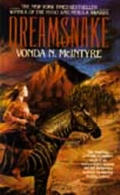
| Publisher: | Bantam |
| Copyright: | 1978 |
| Printing: | October 1994 |
| ISBN: | 0-553-29659-0 |
| Format: | Mass market |
| Pages: | 312 |
Snake is an itinerant healer in a post-apocalyptic world punctuated by radioactive deserts, a world where the surviving technology is primarily biological and genetic. The tools of her trade are snakes, biochemical laboratories that double as syringes. A cobra and a rattlesnake serve as her workhorse factories, made to produce appropriate medicinal venom with carefully chosen chemicals, but most valuable is Grass, a dreamsnake, whose venom neither injures nor cures, but takes away the pain and fear of death in terminal patients.
Dreamsnake has an oddly disjointed structure, leaving me convinced at the conclusion that it was a fix-up novel of several short stories. Apparently it is not, being instead the expansion of the Nebula-winning novelette "Of Mist, and Sand, and Grass" (a better title). I'm now wondering how much of the odd structure was already present in the original novelette and how much was the result of the expansion.
About the only thing that carries over from the beginning to the end of the novel is Snake herself. The concluding villain, apart from a couple of isolated and incomprehensible incidents with little impact on events at the time, fails to even lurk forbodingly until the last hundred pages. The middle of the book is a charming story about beauty and perception, ending in a well-done emotional climax, but has no connection to anything that happened before it and no thematic connection to what follows. Revelations about the world are hinted at and built up, and then the story takes a right turn after only a smattering of details and they're never seen again. It's all very odd.
That's not to say it's bad. McIntyre constructs a fascinating world that lacks the darkness and depression of a lot of apocalyptic fiction and avoids unbelievable disappearances of human knowledge. The infrastructure is gone, but some sciences that could be rebuilt without infrastructure are still present. People have not mysteriously forgotten chemistry or biology, and the healers reasonable extrapolations of medical science that fit the technology levels of the ruins. A liberal sprinkling of subtle differences and hints about the world fall naturally out of the story and are more intriguing for not being relentlessly mined by the author. If you want loose ends wrapped up and glimpses explained, this technique will be unsatisfying, but I appreciated the sense of atmosphere it created.
Other highlights include a matter-of-fact, comfortable, and undramatic treatment of polyamory, a likeable ward for Snake to rescue, some nice bits about snake behavior, and a laudatory avoidance of easy answers (somewhat spoiled by the ending). I could have done without the instant love match, and I thought the ending was rather too convenient and would have needed more support and foreshadowing to be satisfying, but overall I enjoyed the book. I will warn that the narration and dialog clunks at times, mostly avoiding exposition but stumbling over some unfortunately flat bits of text. (Of course, reading a book immediately after a Le Guin novel is not the fairest thing to do to an author.)
Post-apocalyptic stories are far from my favorite sub-genre, but I ended up liking one more than I expected. Recommended for some strong female characters and a nice sense of atmosphere, although don't expect too much of it.
Reviewed: 2005-01-02